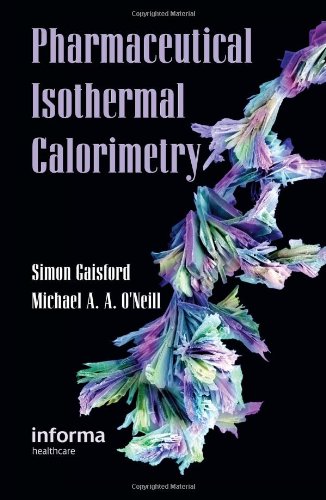Pharmaceutical Isothermal Calorimetry 1st Edition by Simon Gaisford, Michael A A O Neill ISBN 1849730911 9780849331558 by Gaisford Simon, Michael A. A. O'neill 9780849331558, 0849331552 instant download after payment.
Pharmaceutical Isothermal Calorimetry 1st Edition by Simon Gaisford, Michael A A O Neill - Ebook PDF Instant Download/Delivery: 1849730911, 9780849331558
Full download Pharmaceutical Isothermal Calorimetry 1st Edition after payment

Product details:
ISBN 10: 1849730911
ISBN 13: 9780849331558
Author: Simon Gaisford, Michael A A O Neill
Pharmaceutical Isothermal Calorimetry 1st Table of contents:
Part I: Principles and Fundamentals of Isothermal Calorimetry
Chapter 1: Introduction to Calorimetry and Its Pharmaceutical Relevance
- A. What is Calorimetry?
- Basic principles of heat flow and energy changes.
- Different types of calorimetry (DSC, ITC, etc.) and their distinction.
- B. Why Isothermal Calorimetry (ITC) in Pharmaceuticals?
- Advantages of ITC (direct measurement, label-free, wide applicability).
- Overview of applications across drug discovery and development.
- C. Historical Development of ITC and Its Evolution.
Chapter 2: Thermodynamics and Kinetics for Calorimetry
- A. Fundamental Thermodynamic Principles
- Enthalpy, entropy, Gibbs free energy.
- Exothermic and endothermic processes.
- B. Kinetic Aspects of Molecular Interactions
- Reaction rates, activation energy.
- Connection between thermodynamics and kinetics.
- C. Microcalorimetry in Solution: Key Concepts
- Heat of dilution, heat of mixing, heat of binding.
Chapter 3: Instrumentation and Experimental Setup for Isothermal Titration Calorimetry (ITC)
- A. Components of an ITC Instrument
- Sample and reference cells, syringe, stir bar, thermostat.
- B. Operational Principles
- Heat compensation, power feedback mode.
- Data acquisition and signal processing.
- C. Experimental Design Considerations
- Sample preparation, concentrations, buffers, temperature selection.
- Controlling experimental artifacts.
- D. Calibration and Maintenance of ITC Instruments.
Chapter 4: Data Analysis and Interpretation in ITC
- A. Basic Data Processing
- Baseline correction, peak integration.
- B. Binding Models and Fitting Algorithms
- One-site, two-site, sequential binding models.
- Association constant (KA), dissociation constant (KD).
- C. Deriving Thermodynamic Parameters
- Enthalpy change (ΔH), entropy change (ΔS), Gibbs free energy change (ΔG).
- Stoichiometry (n).
- D. Statistical Considerations and Error Analysis.
Part II: Applications of Isothermal Calorimetry in Pharmaceutical Research and Development
Chapter 5: Drug-Target Binding: Characterizing Molecular Interactions
- A. Protein-Ligand Interactions
- Small molecule drugs, peptides, antibodies.
- Characterization of specificity and affinity.
- B. DNA/RNA-Ligand Interactions
- Binding to nucleic acids.
- C. Protein-Protein Interactions
- Dimerization, complex formation.
- D. Enzyme Kinetics and Inhibitor Binding
- Measuring Km, Vmax, and inhibitor dissociation constants.
Chapter 6: Formulations and Stability Studies
- A. Protein Stability and Folding/Unfolding
- Thermal and chemical denaturation.
- Conformational stability.
- B. Ligand-Induced Stabilization/Destabilization of Proteins.
- C. Excipient Compatibility Studies
- Interaction between active pharmaceutical ingredients (APIs) and excipients.
- D. Polymorphism and Solid-State Characterization
- Heat associated with phase transitions.
- E. Amorphous vs. Crystalline Form Stability.
Chapter 7: Biologics and Biosimilars Characterization
- A. Antibody-Antigen Binding
- Epitope mapping, binding affinity for therapeutic antibodies.
- B. Protein Aggregation and Colloidal Stability.
- C. Biosimilarity Assessment.
- D. Vaccine Formulation and Stability.
Chapter 8: Membrane Protein Interactions and Drug Discovery
- A. Challenges of Membrane Protein Studies by ITC.
- B. Detergent Micelle Interactions.
- C. Lipid-Protein Binding and Reconstitution Systems.
Chapter 9: High-Throughput and Automation in Pharmaceutical ITC
- A. Automation of ITC Experiments.
- B. Miniaturization and Sample Conservation.
- C. Integration with Other Biophysical Techniques.
Part III: Advanced Topics and Future Perspectives
Chapter 10: Advanced Data Analysis and Modeling
- A. Global Fitting and Complex Binding Models.
- B. Deconvolution of Thermograms.
- C. Beyond Simple Binding: Allosteric Effects, Cooperativity.
Chapter 11: Challenges and Limitations of Pharmaceutical ITC
- A. Sample Purity and Activity.
- B. Low Affinity Binding.
- C. High Buffer Heats and Specific Buffer Selection.
- D. Data Reproducibility and Inter-Laboratory Variability.
Chapter 12: Complementary Techniques to ITC in Drug Discovery
- A. Surface Plasmon Resonance (SPR).
- B. MicroScale Thermophoresis (MST).
- C. Nuclear Magnetic Resonance (NMR).
- D. Differential Scanning Calorimetry (DSC).
- E. X-ray Crystallography and Cryo-EM.
Chapter 13: Emerging Trends and Future Directions
- A. New ITC Instrument Technologies.
- B. Applications in Gene Therapy and Cell Therapy.
- C. AI and Machine Learning in ITC Data Interpretation.
- D. The Role of ITC in Personalized Medicine.
People also search for Pharmaceutical Isothermal Calorimetry 1st:
pharmaceutical isothermal calorimetry
isothermal calorimetry
isothermal calorimeter
isothermal microcalorimetry
isothermal scanning calorimetry
Tags: Simon Gaisford, Michael A A O Neill, Pharmaceutical, Isothermal



